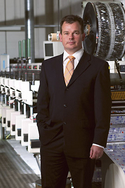Servo driven web control
13 March 2006OPM Group business development director Darren Kaye says the three main advantages of a servodrive are improved control and conversion of complex materials on the press, quicker set-up times and reduced wastage
OPM specializes in short run packaging, often for market trials or consumer testing. Clients want innovative packaging, and we are constantly pushing the tolerances of substrates that we can manage on the press. The company has won more than 50 international awards for technical print excellence over the past four years.
A servodrive on a Nilpeter FA 3300 enabled us to produce a technically challenging food wrapper that achieved Best of Category award at the 2005 FlexoTech awards.
We produced a flowwrap product for sports nutrition company LA Muscle that beat competition from Disney and Macleans. OPM was asked to produce a distinctive wrapper, on a very thin flexible film. Essentially, the material was ‘high slip’, which would have been a struggle on a conventional press. Film based labels and foils look fantastic as converted packaging, but as unsupported base materials, they can be very difficult to control, and are prone to stretch and slip on press. This directly affects print registration and reliable repeat lengths.
With a flowwrap packaging item like this, our client also had to be confident that the press would provide a precise repeat length, so that the packing line could achieve product sealing at the precise repeat interval. It’s in this environment that a servo press comes into its own. Each servodrive uses electronic feedback from its printhead. It makes thousands of subtle adjustments per minute to the tension of the material running across the press.
For the LA Muscle packaging, the servo meant that we were able to minimize unnecessary stretch, and ensure that we achieved very fine detail in term of registration. Also, the degree of control that the servo provides meant that the colour accuracy and ink density lived up to every subtle detail in the original artwork and repro.
The digital capability of the servo, and its computerized control unit mean quicker set-up times. Production set-up time is critical to the economics of any conversion business – especially when you are managing short runs. The digital memory of a servo press offers a pre-register capability where the printing plate automatically rotates to a pre-determined position. This means that when the press is started it is already in near-perfect register. The tension control of a servo driven press also enables converters to increase their presses up to optimum running quickly, very quickly.
As well as faster makeready times, the electronic memory of servo presses allows previous production data to be stored, recalled, and re-used, with very quick press set-ups. Not only can we create award winning work, we can create it again and again, months or years apart.
Material costs are important to any converter, especially one dealing with high value substrates and short runs. For OPM, short servo set-up times mean that there is little waste. The press achieves perfect registration much more quickly and waste substrate at start-up is very small. This has cost benefits which we pass onto clients. The benefits of a servo press are demonstrable. Set-up speeds are reduced and initial registration capabilities are first rate. The consistency of the servodrive also means that production speeds can be ramped up quickly with no damage to the substrates – especially flexibles.
FilesContactExternal weblinksConverting Today is not responsible for the content of external internet sites.The OPM Group FilesContact



